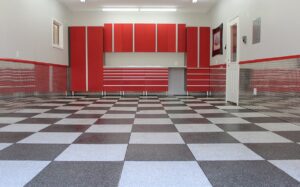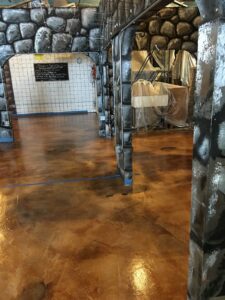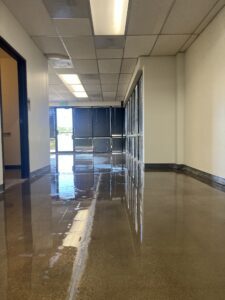BLOG
Many developers in the Denver area have decided that luxury residential complexes are the best choice for their long term financial goals. But for a residential complex to qualify as luxury, it has to be luxurious. It also has to match the developer’s long term goals, branding, and more. Flooring plays a tremendous part in this. Developers need the right balance between affordable and high end, so that they can easily rent or sell the complexes while also improving their profitability. Concrete flooring, often associated with industrial and commercial settings, is one of the flooring options that is gaining popularity in luxury residential complexes for this reason – its unique combination of aesthetics and practicality. If you’re building a luxury residential complex of any kind and are looking for concrete flooring specialists, please contact Colorado Concrete Repair to learn more about our services. Benefits of Concrete Flooring for Residential Complexes Concrete flooring can be designed in ways that are absolutely luxury, provided you partner with the right team. They can offer: Aesthetic Versatility Concrete flooring offers remarkable aesthetic versatility, making […]
...READ MOREWhen someone is planning the design of their data center, it’s not uncommon to for the flooring of the space to be one of the components that is least discussed and considered. After all, there are a lot of factors that go into creating a safe and effective tech space, and it’s not uncommon to ignore the part that goes on beneath your feet. But this is a mistake. In fact, the choice of flooring in these facilities plays a significant role in maintaining operational efficiency and protecting valuable assets, and the effects of making the wrong choice can be significant. What Type of Flooring Should You Choose for Tech/Data? In the tech and data world, the best type of flooring is going to be concrete flooring. Concrete flooring offers several advantages that make it an ideal choice for tech and data centers, with benefits that include, but are not limited to: Durability – Concrete flooring is known for its exceptional durability and longevity. In tech and data centers, where heavy equipment and constant foot traffic are common, a durable […]
...READ MORECommercial concrete flooring is not only favored for its strength and durability but also for its ability to be transformed aesthetically through various coloring techniques. We often think of this flooring as grey or drab, but concrete can be colored in ways that match the design that you envision for the property. Whether the goal is to align with brand colors, enhance interior design, or simply differentiate spaces, adding color to concrete flooring is an effective strategy. For more detailed information about your specific problem, make sure you contact Colorado Concrete Repair, today. Techniques for Coloring Commercial Concrete Flooring There are many techniques that may be used to add color to concrete, and there are different advantages and disadvantages to each. Some examples include: Integral Coloring – This method involves adding pigments directly to the concrete mix before it is poured. The color is integrated throughout the entire volume of concrete, providing a uniform color that will not wear off with surface abrasion. Integral coloring is a reliable method for achieving consistent tones in large areas. Concrete Stains – There […]
...READ MORECommercial concrete flooring is not only praised for its durability and cost-effectiveness but also for its versatility. Concrete is not limited to grey alone. It has many possible aesthetic capabilities, allowing you to create or mimic many different types of flooring in order to have the benefits of concrete with the aesthetics of other flooring options. Customization Options for Concrete Flooring Modern advancements in concrete technology and finishing techniques allow for a wide range of colors and designs. Modern concrete floors can be customized in virtually any color. Techniques such as staining, dyeing, and integral coloring are used to achieve an extensive palette of shades. Stains can create rich, variegated effects, while dyes offer vibrant, uniform colors. Integral coloring involves adding pigments directly to the concrete mix, ensuring the color runs throughout the thickness of the slab, which provides lasting color that won’t wear away. Concrete flooring can also be designed to mimic other materials, such as granite, slate, brick, or wood, offering a cost-effective alternative with reduced maintenance. Stamping concrete while it’s still wet can imprint it with patterns […]
...READ MOREConcrete makes for one of the best commercial flooring solutions in Denver. When people think of concrete, however, they typically imagine it to be this flat, grey finish. Commercial concrete flooring can be so much more than that, offering not only different colors, but textures, to elevate the visual aesthetics of your space. Types of Surface Textures for Commercial Concrete There are many surface textures available for commercial concrete flooring, each one offering different visual appeal. Examples of possible concrete surface textures include: Broom Finish – One of the most common textures, a broom finish is achieved by pulling a broom over freshly laid concrete. This technique creates a rough surface that provides excellent traction, even in wet conditions. Stamped Concrete – To mimic other materials like brick, stone, or wood, stamped concrete is an ideal choice. Patterns are pressed into the freshly poured concrete using large stamps. This method is popular for creating decorative patios, walkways, and other outdoor spaces, but can be used for indoor commercial flooring as well. . Exposed Aggregate – This texture involves removing the […]
...READ MOREConcrete as a flooring material is often associated with industrial or single-story commercial buildings. Part of this is because of how heavy concrete is, but also because the way that many properties are designed is not necessarily to appeal to those that might need concrete flooring. It may also not have been the low cost solution that some builders were looking for. However, its application in multi-story commercial properties is not only viable but also increasingly popular due to its durability, versatility, and aesthetic appeal. This shift in perception is underpinned by technological advancements and innovative design approaches that have expanded the suitability of concrete flooring to a broader range of commercial environments, including multi-story structures. Structural Considerations The primary concern when considering concrete for multi-story commercial properties is the structural load. Concrete is inherently heavier than some alternative flooring materials, necessitating a thorough assessment of the building’s structural integrity and load-bearing capacity. Modern construction techniques and materials, such as lightweight concrete and reinforced concrete slabs, offer solutions that mitigate these concerns, making concrete floors a feasible option for upper […]
...READ MORE




